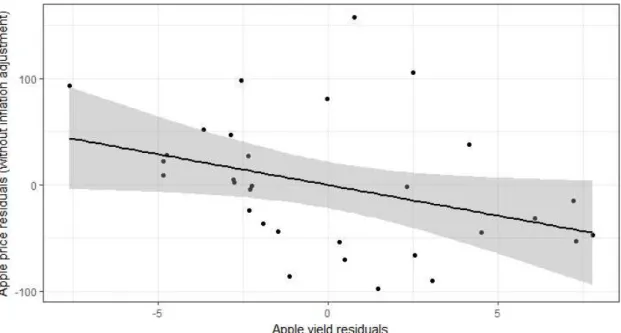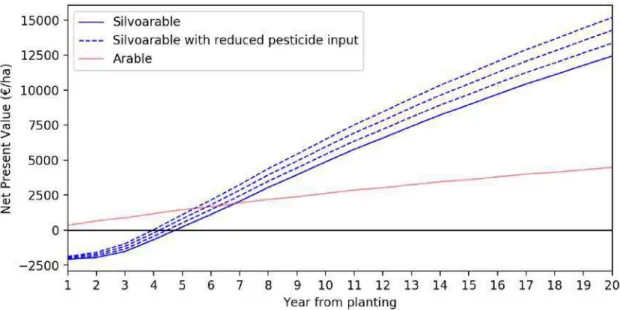A COST-EFFECTIVENESS ANALYSIS OF TEMPERATE
SILVOARABLE SYSTEMS: WHAT CONTRIBUTION DO
ECOSYSTEM SERVICES MAKE?
Staton T1*, Walters R2, Smith J3, Chesshire H4, Girling R1
(1) School of Agriculture, Policy and Development, University of Reading, Reading, UK (2) School of Biological Sciences, University of Reading, Reading, UK (3) Organic Research Centre, Elm Farm, Newbury, UK (4) Woodland
Trust, Grantham, UK
*Corresponding author: T.Staton@pgr.reading.ac.uk
Abstract
Silvoarable systems generally support higher biodiversity, but there is limited understanding as to the value of associated ecosystem services such as pest regulation and pollination. This paper reports on preliminary results of a cost effectiveness analysis of apple silvoarable systems, as part of a PhD investigating the influence of silvoarable management on biodiversity-derived ecosystem services. Our results suggest that profitability of an apple alley-cropping system should exceed that of an equivalent arable system six to seven years post-establishment for a typical conventional farm in the UK. This result is strongly influenced by farm productivity and stochastic variability in apple yields, although the latter is partly compensated by price. Biodiversity-derived ecosystem services could improve profitability, for example by reducing inputs and improving yields. However, this analysis is constrained by a scarcity of empirical data. Therefore, we aim to collect data on pest regulation and pollination from a network of silvoarable sites.
Keywords: apple; arable; alley cropping; biodiversity; sensitivity analysis; profitability
Introduction
Silvoarable systems have the potential to be an effective and productive form of sustainable agriculture, in part due to the enhancement of biodiversity and associated ecosystem services. However, currently there is limited understanding of how higher biodiversity in silvoarable systems promotes ecosystem services, such as pest regulation, pollination and nutrient cycling (for example, see Peng et al. 1993; Thevathasan and Gordon 2004; Varah et al. 2013), versus ecosystem disservices, such as encouraging certain pests and weeds (Griffiths et al. 1998; Burgess et al. 2003), and, furthermore, how this cost-benefit ratio might change with how the system is designed, managed and matures over time (but see Burgess et al 2003; Stamps et al. 2009).
This paper reports on preliminary results of a cost effectiveness analysis based on the Farm-SAFE model (Graves et al. 2011; 2016), as part of a PhD investigating how management of silvoarable influences biodiversity-derived ecosystem services, and their economic implications. Our study is focussed on silvoarable systems in the UK that combine top-fruit production with arable alley-cropping, which are emerging as a promising design with limited shade effects (Smith et al. 2016). We compare our findings to a monocropped arable system, with and without purported associated biodiversity benefits (Varah et al. 2013, 2015).
Materials and methods
The profitability and financial resilience of silvoarable systems, and the potential contribution of ecosystem services, will be evaluated by a cost effectiveness analysis conducted on the Farm-SAFE model. First, we are comparing the profitability of a silvoarable versus a monocrop arable
298 4th European Agroforestry Conference Agroforestry as Sustainable Land Use
system, conducting a sensitivity analysis to establish the robustness of our findings in relation to price fluctuations, yield fluctuations, crop rotations, organic vs. conventional management, system design and other farm-specific factors. Our initial findings presented here are based on a conventional winter wheat / winter wheat / oilseed rape rotation, using 24 m wide crop alleys separated by 3 m wide apple tree rows. These figures will be used as the basis to establish the potential contribution of biodiversity derived ecosystem (dis)services based on forthcoming field surveys and assumptions around improved crop yield/quality and reduced input requirements. This analysis will ultimately serve as the basis for exploring the financial resilience of silvoarable to future economic risk scenarios, such as pesticide resistance, pesticide bans and honey bee declines.
Results and discussion
Silvoarable requires an initial investment in terms of tree establishment costs. Additionally, there is an annual loss of income associated with taking land out of arable production. However, fruit production can deliver higher profits in the long-term. The time taken for establishment costs to be recuperated and for profitability to exceed an equivalent arable system are therefore key factors in encouraging uptake of silvoarable. Based on typical yields and prices for a conventional wheat-based rotation, we predict that silvoarable profitability would exceed an equivalent monocrop arable at six to seven years after establishment. However, this result is sensitive to variation in prices and yields due to site characteristics, weather and stochasticity. Apple yields fluctuate due to weather conditions and therefore vary to a far greater extent than wheat yields. For example, over the period 1985 to 2016, wheat yield in the UK varied between 6.0 and 9.0 t/ha (+50%) compared to apple yields of 10.9 and 29.1 t/ha (+167%). This could add some element of risk to top-fruit silvoarable systems. Using historic trends to predict upper and lower apple yields based on 95% prediction intervals, the time taken for modelled silvoarable profitability to exceed arable is predicted to range between five and ten years depending on yield (Figure 1a). However, very low yields are historically compensated by higher prices (Figure 2), which could improve the financial resilience of silvoarable to low apple yields. Therefore, we are investigating simulations using random samples from a distribution based on the interaction.
Figure 1: Influence of apple yield variation on silvoarable profitability, based on (a) historic national yield variations, where solid line represents the predicted 2015 yield using a linear model derived from historic yields, and dotted lines represent yields based on the 95% level of production (solid lines), using yield values in the John Nix pocketbook (Redman 2017).
Figure 2: Relationship between apple yield and price residuals (p=0.0524), based on linear models of their respective historic UK trends with time using FAOSTAT data.
Farm characteristics such as soil productivity and location can also strongly influence yields of both the arable and top-fruit components. A simulation using low, average and high yields for both apple and arable components as specified in the John Nix Pocketbook (Redman 2017), which reflect variation in productivity due to farm-specific factors, shows that the profitability of silvoarable relative to an equivalent monocropped arable is strongly influenced by the achievable yield (Figure 1b). For farms with high production levels, silvoarable profitability is predicted to exceed arable at six years, but this increases to 11 years for low productivity situations. Enhanced ecosystem services in silvoarable could help to increase production levels and profitability, for example by reducing pollination deficits.
Ecosystem services derived from biodiversity could also contribute to silvoarable profitability and financial resilience by reducing pesticide input requirements. Although empirical data is lacking as to whether enhanced conservation biological control (CBC) could allow inputs to be reduced in temperate silvoarable systems without incurring a net cost, enhanced CBC arising from hedgerow restoration in California was predicted to reduce insecticide input requirements by 75% (Morandin et al. 2016). If pesticide costs were reduced by 75% in silvoarable, the time taken for profitability to exceed arable is reduced by one year, and net present value at 20 years increases by 22% compared to typical pesticide use (Figure 3). More empirical data is required to inform our understanding as to the contribution of ecosystem services to silvoarable profitability and resilience.
300 4th European Agroforestry Conference Agroforestry as Sustainable Land Use
Figure 3: Effect of reducing pesticide costs by 25%, 50% and 75% in silvoarable.
Conclusions and future research
Silvoarable systems based on top-fruit production have potential to provide a relatively rapid return on investment, albeit this is strongly influenced by variables such as apple yield and farm productivity. Ecosystem services derived from biodiversity could improve profitability, for example conservation biological control could reduce input requirements in conventional systems and improve yields in organic systems, whilst pollination services could enhance apple yield and quality. Financial resilience against future risks such as pesticide regulations, resistance and pollinator declines could also be enhanced. However, the quantification of any such benefits is constrained by a paucity of empirical data.
Therefore, the next steps of the project are to carry out biodiversity field surveys at three silvoarable sites in the UK over a three-year period from 2018, to establish the link between biodiversity and ecosystem services and how these are influenced by system design and management. Specifically, we will investigate the associations between natural enemies and pests, and pollinators and pollination, in relation to tree alley width and tree row understorey management, from naturally colonised vegetation to the active maintenance of bare ground, seeding of wildflower mixes and horticultural production.
We plan to incorporate the empirical data collected over the course of the project to inform the financial modelling, with the objective of predicting the value of ecosystem services derived from biodiversity in silvoarable systems, and the influence of management options. This will help to inform policy makers and farmers as to the most effective system designs and the potential financial risks and rewards of silvoarable systems as an alternative to monocropped arable.
References
Burgess PJ, Incoll LD, Hart BJ, Beaton A, Piper RW, Seymour I, Reynolds FH, Wright C, Pilbeam DJ, Graves AR (2003) The impact of silvoarable agroforestry with poplar on farm profitability and biological diversity. Defra Report. Graves AR, Burgess PJ, Liagre F, Terreaux J-P, Borrel T, Dupraz C, Palma J, Herzog F (2011) Farm-SAFE: the
process of developing a plot- and farm-scale model of arable, forestry and silvoarable economics. Agrofor Syst 81: 93-108.
Graves A, Palma J, de Jalon SG, Crous-Duran J, Liagre F, Burgess P (2016) Farm-SAFE: financial and resource-use model for simulating agroforestry in Europe. AGFORWARD. https://www.agforward.eu (accessed 30/04/2018).
Griffiths J, Phillips DS, Compton SG, Wright C, Incoll LD (1998) Responses of slug numbers and slug damage to crops in a silvoarable agroforestry landscape. J Appl Ecol 35: 252-260.
Morandin LA, Long RF, Kremen C (2016) Pest control and pollination cost-benefit analysis of hedgerow restoration in a simplified agricultural landscape. J Econ Entomol 109: 1020-1027.
Peng RK, Incoll LD, Sutton SL, Wright C, Chadwick A (1993) Diversity of airborne arthropods in a silvoarable agroforestry system. J Appl Ecol 30: 551-62.
Redman G (2017) John Nix Pocketbook for Farm Management. 48th edition. Agro Business Consultants Ltd.
Smith J, Wolfe M, Crossland M (2016) Silvoarable agroforestry: an alternative approach to apple production? 12th European International Farming Systems Association Symposium.
Stamps WT, McGraw RL, Godsey L, Woods TL (2009) The ecology and economics of insect pest management in nut tree alley cropping systems in the Midwestern United States. Agr Ecosyst Environ 131: 4-8.
Thevathasan NV, Gordon AM (2004) Ecology of tree intercropping systems in the north temperate region: experiences from Southern Ontario, Canada. Agrofor Syst 61: 257-68.
Varah A, Jones H, Smith J, Potts SG (2013) Enhanced biodiversity and pollination in UK agroforestry systems. J Sci Food Agr 93: 2073-75.
Varah A (2015) Can agroforestry reconcile conflicting demands for productivity, biodiversity conservation and delivery of ecosystem services? PhD thesis, University of Reading, UK.


